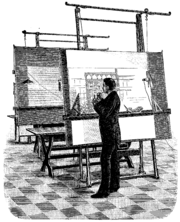Defining a design process
According to video game developer Dino Dini in a talk given at the 2005 Game Design and Technology Workshop held by Liverpool JM University, design underpins every form of creation from objects such as chairs to the way we plan and execute our lives. For this reason it is useful to seek out some common structure that can be applied to any kind of design, whether this be for video games, consumer products or one's own personal life.
For such an important concept, the question "What is Design?" appears to yield answers with limited usefulness. Dino Dini states that the design process can be defined as "The management of constraints". He identifies two kinds of constraint, negotiable and non-negotiable. The first step in the design process is the identification, classification and selection of constraints. The process of design then proceeds from here by manipulating design variables so as to satisfy the non-negotiable constraints and optimizing those which are negotiable. It is possible for a set of non-negotiable constraints to be in conflict resulting in a design with no solution; in this case the non-negotiable constraints must be revised. For example, take the design of a chair. A chair must support a certain weight to be useful, and this is a non-negotiable constraint. The cost of producing the chair might be another. The choice of materials and the aesthetic qualities of the chair might be negotiable.
Dino Dini theorizes that poor designs occur as a result of mismanaged constraints, something he claims can be seen in the way the video game industry makes "Must be Fun" a negotiable constraint where he believes it should be non-negotiable.
It should be noted that "the management of constraints" may not include the whole of what is involved in "constraint management" as defined in the context of a broader Theory of Constraints, depending on the scope of a design or a designer's position.

Typical steps
A design process may include a series of steps followed by designers. Depending on the product or service, some of these stages may be irrelevant, ignored in real-world situations in order to save time, reduce cost, or because they may be redundant in the situation.
Typical stages of the design process include:
- Pre-production design
- Design brief - a statement of design goals
- Analysis - analysis of current design goals
- Research - investigating similar design solutions in the field or related topics
- Specification - specifying requirements of a design solution for a product (product design specification[2]) or service.
- Problem solving - conceptualizing and documenting design solutions
- Presentation - presenting design solutions
- Design during production
- Development - continuation and improvement of a designed solution
- Testing - in-situ testing a designed solution
- Post-production design feedback for future designs
- Implementation - introducing the designed solution into the environment
- Evaluation and conclusion - summary of process and results, including constructive criticism and suggestions for future improvements
- Redesign - any or all stages in the design process repeated (with corrections made) at any time before, during, or after production.







No comments:
Post a Comment